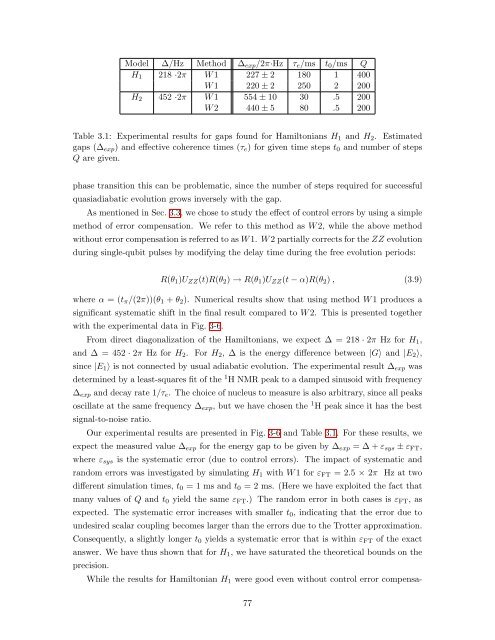Ph.D. Thesis - Physics
Ph.D. Thesis - Physics
Ph.D. Thesis - Physics
You also want an ePaper? Increase the reach of your titles
YUMPU automatically turns print PDFs into web optimized ePapers that Google loves.
Model ∆/Hz Method ∆exp/2π·Hz τe/ms t0/ms Q<br />
H1 218 ·2π W1 227 ± 2 180 1 400<br />
W1 220 ± 2 250 2 200<br />
H2 452 ·2π W1 554 ± 10 30 .5 200<br />
W2 440 ± 5 80 .5 200<br />
Table 3.1: Experimental results for gaps found for Hamiltonians H1 and H2. Estimated<br />
gaps (∆exp) and effective coherence times (τe) for given time steps t0 and number of steps<br />
Q are given.<br />
phase transition this can be problematic, since the number of steps required for successful<br />
quasiadiabatic evolution grows inversely with the gap.<br />
As mentioned in Sec. 3.3, we chose to study the effect of control errors by using a simple<br />
method of error compensation. We refer to this method as W2, while the above method<br />
without error compensation is referred to as W1. W2 partially corrects for the ZZ evolution<br />
during single-qubit pulses by modifying the delay time during the free evolution periods:<br />
R(θ1)UZZ(t)R(θ2) → R(θ1)UZZ(t − α)R(θ2) , (3.9)<br />
where α = (tπ/(2π))(θ1 + θ2). Numerical results show that using method W1 produces a<br />
significant systematic shift in the final result compared to W2. This is presented together<br />
with the experimental data in Fig. 3-6.<br />
From direct diagonalization of the Hamiltonians, we expect ∆ = 218 · 2π Hz for H1,<br />
and ∆ = 452 · 2π Hz for H2. For H2, ∆ is the energy difference between |G〉 and |E2〉,<br />
since |E1〉 is not connected by usual adiabatic evolution. The experimental result ∆exp was<br />
determined by a least-squares fit of the 1 H NMR peak to a damped sinusoid with frequency<br />
∆exp and decay rate 1/τe. The choice of nucleus to measure is also arbitrary, since all peaks<br />
oscillate at the same frequency ∆exp, but we have chosen the 1 H peak since it has the best<br />
signal-to-noise ratio.<br />
Our experimental results are presented in Fig. 3-6 and Table 3.1. For these results, we<br />
expect the measured value ∆exp for the energy gap to be given by ∆exp = ∆ + εsys ± εFT,<br />
where εsys is the systematic error (due to control errors). The impact of systematic and<br />
random errors was investigated by simulating H1 with W1 for εFT = 2.5 × 2π Hz at two<br />
different simulation times, t0 = 1 ms and t0 = 2 ms. (Here we have exploited the fact that<br />
many values of Q and t0 yield the same εFT.) The random error in both cases is εFT, as<br />
expected. The systematic error increases with smaller t0, indicating that the error due to<br />
undesired scalar coupling becomes larger than the errors due to the Trotter approximation.<br />
Consequently, a slightly longer t0 yields a systematic error that is within εFT of the exact<br />
answer. We have thus shown that for H1, we have saturated the theoretical bounds on the<br />
precision.<br />
While the results for Hamiltonian H1 were good even without control error compensa-<br />
77
















